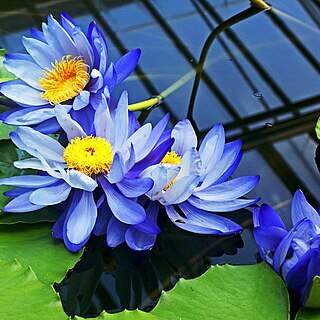Perennial; rhizome globular. Leaf lamina orbicular, to c. 80 cm wide, with regularly-spaced teeth to 5 mm long; undersurface glabrous. Flowers to 50 cm above water. Sepals 4, to 11 cm long, obtuse, small purple streaks may be present. Petals to 32, oblanceolate to spathulate, obtuse, blue, white or rarely pink, fading with age. Stamens to c. 400; filaments cylindrical, to 30 mm long; anthers to 11 mm long, rarely apiculate. Carpels 12–18; sterile stigmatic lobes vestigial or obsolete. Fruit c. 5 cm diam. Seeds ovate, c. 4 mm long, c. 2.5 mm wide, with ± continuous rows of short hairs.

